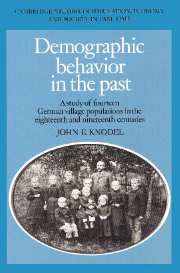 Demographic Behavior in the Past
Demographic Behavior in the Past Book contents
- Frontmatter
- Contents
- List of tables
- List of figures
- Acknowledgements
- PART I INTRODUCTION
- PART II MORTALITY
- PART III FAMILY FORMATION
- PART IV MARITAL REPRODUCTION
- 10 Trends in marital fertility and underlying natural fertility components
- 11 From natural fertility to family limitation
- 12 Starting, stopping, spacing and the fertility transition
- PART V INTERRELATIONSHIPS IN DEMOGRAPHIC BEHAVIOR
- PART VI CONCLUSION
- Appendices
- Bibliography
- Index
12 - Starting, stopping, spacing and the fertility transition
Published online by Cambridge University Press: 04 August 2010
- Frontmatter
- Contents
- List of tables
- List of figures
- Acknowledgements
- PART I INTRODUCTION
- PART II MORTALITY
- PART III FAMILY FORMATION
- PART IV MARITAL REPRODUCTION
- 10 Trends in marital fertility and underlying natural fertility components
- 11 From natural fertility to family limitation
- 12 Starting, stopping, spacing and the fertility transition
- PART V INTERRELATIONSHIPS IN DEMOGRAPHIC BEHAVIOR
- PART VI CONCLUSION
- Appendices
- Bibliography
- Index
Summary
Although the concept of family limitation has been defined as a strategy of limiting births through stopping behavior, a logical alternative strategy could be the limitation of births through efforts both to deliberately prolong intervals between births and to delay the start of childbearing following marriage. A fuller understanding of behavioral changes underlying the fertility transition clearly requires assessment of the part played by birth spacing in the reproductive changes that were taking place. Moreover, since the final number of children a couple has also depends on the age at which reproduction begins, consideration needs to be given to when childbearing is initiated. This chapter starts, therefore, by examining the role of birth-spacing patterns in the shift to deliberate marital fertility control. This then leads to a more comprehensive analysis which attempts to assess, within a single integrated framework, the relative contribution of starting, spacing, and stopping behavior during the initial phases of the fertility transition. Finally, given the dominance of stopping behavior indicated by this analysis, an attempt is also made to estimate the proportion of couples who deliberately attempted to limit family size by earlier cessation of childbearing.
Birth spacing
The measures of fertility control that have been examined so far are primarily designed to detect attempts to stop childbearing, and reveal little, if anything, about birth-spacing patterns.
- Type
- Chapter
- Information
- Demographic Behavior in the PastA Study of Fourteen German Village Populations in the Eighteenth and Nineteenth Centuries, pp. 318 - 350Publisher: Cambridge University PressPrint publication year: 1988


